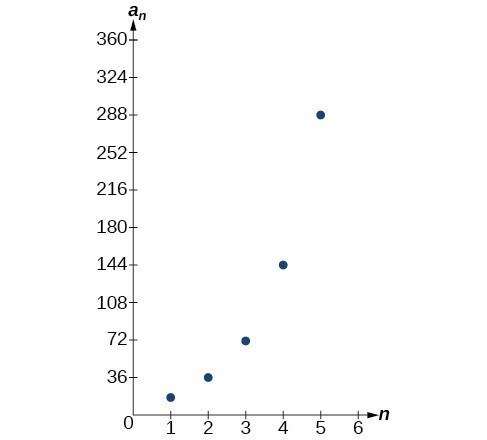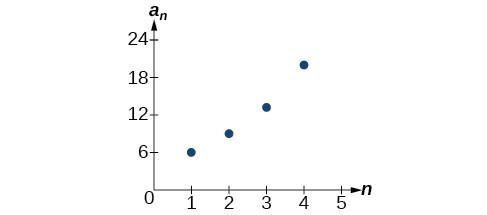Learning Outcomes
- Find the common ratio for a geometric sequence.
- List the terms of a geometric sequence.
- Use a recursive formula for a geometric sequence.
- Use an explicit formula for a geometric sequence.
Many jobs offer an annual cost-of-living increase to keep salaries consistent with inflation. Suppose, for example, a recent college graduate finds a position as a sales manager earning an annual salary of $26,000. He is promised a 2% cost of living increase each year. His annual salary in any given year can be found by multiplying his salary from the previous year by 102%. His salary will be $26,520 after one year; $27,050.40 after two years; $27,591.41 after three years; and so on. When a salary increases by a constant rate each year, the salary grows by a constant factor. In this section we will review sequences that grow in this way.
Terms of Geometric Sequences
Finding Common Ratios
The yearly salary values described form a geometric sequence because they change by a constant factor each year. Each term of a geometric sequence increases or decreases by a constant factor called the common ratio. The sequence below is an example of a geometric sequence because each term increases by a constant factor of 6. Multiplying any term of the sequence by the common ratio 6 generates the subsequent term.

A General Note: Definition of a Geometric Sequence
A geometric sequence is one in which any term divided by the previous term is a constant. This constant is called the common ratio of the sequence. The common ratio can be found by dividing any term in the sequence by the previous term. If [latex]{a}_{1}[/latex] is the initial term of a geometric sequence and [latex]r[/latex] is the common ratio, the sequence will be
[latex]\left\{{a}_{1}, {a}_{1}r,{a}_{1}{r}^{2},{a}_{1}{r}^{3},...\right\}[/latex].
How To: Given a set of numbers, determine if they represent a geometric sequence.
- Divide each term by the previous term.
- Compare the quotients. If they are the same, a common ratio exists and the sequence is geometric.
Example: Finding Common Ratios
Is the sequence geometric? If so, find the common ratio.
- [latex]1,2,4,8,16,\dots[/latex]
- [latex]48,12,4,2,\dots[/latex]
Q & A
If you are told that a sequence is geometric, do you have to divide every term by the previous term to find the common ratio?
No. If you know that the sequence is geometric, you can choose any one term in the sequence and divide it by the previous term to find the common ratio.
Try It
Is the sequence geometric? If so, find the common ratio.
[latex]5,10,15,20,\dots[/latex]
Try It
Is the sequence geometric? If so, find the common ratio.
[latex]100,20,4,\dfrac{4}{5},\dots[/latex]
Writing Terms of Geometric Sequences
Now that we can identify a geometric sequence, we will learn how to find the terms of a geometric sequence if we are given the first term and the common ratio. The terms of a geometric sequence can be found by beginning with the first term and multiplying by the common ratio repeatedly. For instance, if the first term of a geometric sequence is [latex]{a}_{1}=-2[/latex] and the common ratio is [latex]r=4[/latex], we can find subsequent terms by multiplying [latex]-2\cdot 4[/latex] to get [latex]-8[/latex] then multiplying the result [latex]-8\cdot 4[/latex] to get [latex]-32[/latex] and so on.
[latex]\begin{align}&{a}_{1}=-2 \\ &{a}_{2}=\left(-2\cdot 4\right)=-8 \\ &{a}_{3}=\left(-8\cdot 4\right)=-32 \\ &{a}_{4}=\left(-32\cdot 4\right)=-128 \end{align}[/latex]
The first four terms are [latex]\left\{-2,-8,-32,-128\right\}[/latex].
How To: Given the first term and the common factor, find the first four terms of a geometric sequence.
- Multiply the initial term, [latex]{a}_{1}[/latex], by the common ratio to find the next term, [latex]{a}_{2}[/latex].
- Repeat the process, using [latex]{a}_{n}={a}_{2}[/latex] to find [latex]{a}_{3}[/latex] and then [latex]{a}_{3}[/latex] to find [latex]{a}_{4,}[/latex] until all four terms have been identified.
- Write the terms separated by commons within brackets.
Example: Writing the Terms of a Geometric Sequence
List the first four terms of the geometric sequence with [latex]{a}_{1}=5[/latex] and [latex]r=-2[/latex].
Try It
List the first five terms of the geometric sequence with [latex]{a}_{1}=18[/latex] and [latex]r=\dfrac{1}{3}[/latex].
Explicit Formulas for Geometric Sequences
Using Recursive Formulas for Geometric Sequences
A recursive formula allows us to find any term of a geometric sequence by using the previous term. Each term is the product of the common ratio and the previous term. For example, suppose the common ratio is 9. Then each term is nine times the previous term. As with any recursive formula, the initial term must be given.
A General Note: Recursive Formula for a Geometric Sequence
The recursive formula for a geometric sequence with common ratio [latex]r[/latex] and first term [latex]{a}_{1}[/latex] is
[latex]{a}_{n}=r\cdot{a}_{n - 1},n\ge 2[/latex]
How To: Given the first several terms of a geometric sequence, write its recursive formula.
- State the initial term.
- Find the common ratio by dividing any term by the preceding term.
- Substitute the common ratio into the recursive formula for a geometric sequence.
Example: Using Recursive Formulas for Geometric Sequences
Write a recursive formula for the following geometric sequence.
[latex]\left\{6,9,13.5,20.25,\dots\right\}[/latex]
Q & A
Do we have to divide the second term by the first term to find the common ratio?
No. We can divide any term in the sequence by the previous term. It is, however, most common to divide the second term by the first term because it is often the easiest method of finding the common ratio.
Try It
Write a recursive formula for the following geometric sequence.
[latex]\left\{2,\dfrac{4}{3},\dfrac{8}{9},\dfrac{16}{27},\dots\right\}[/latex]
Using Explicit Formulas for Geometric Sequences
Because a geometric sequence is an exponential function whose domain is the set of positive integers, and the common ratio is the base of the function, we can write explicit formulas that allow us to find particular terms.
[latex]{a}_{n}={a}_{1}{r}^{n - 1}[/latex]
Let’s take a look at the sequence [latex]\left\{18\text{, }36\text{, }72\text{, }144\text{, }288\text{, }...\right\}[/latex]. This is a geometric sequence with a common ratio of 2 and an exponential function with a base of 2. An explicit formula for this sequence is
[latex]{a}_{n}=18\cdot {2}^{n - 1}[/latex]

A General Note: Explicit Formula for a Geometric Sequence
The nth term of a geometric sequence is given by the explicit formula:
[latex]{a}_{n}={a}_{1}{r}^{n - 1}[/latex]
Example: Writing Terms of Geometric Sequences Using the Explicit Formula
Given a geometric sequence with [latex]{a}_{1}=3[/latex] and [latex]{a}_{4}=24[/latex], find [latex]{a}_{2}[/latex].
Try It
Given a geometric sequence with [latex]{a}_{2}=4[/latex] and [latex]{a}_{3}=32[/latex] , find [latex]{a}_{6}[/latex].
Example: Writing an Explicit Formula for the nth Term of a Geometric Sequence
Write an explicit formula for the [latex]n\text{th}[/latex] term of the following geometric sequence.
[latex]\left\{2,10,50,250,\dots\right\}[/latex]
Try It
Write an explicit formula for the following geometric sequence.
[latex]\left\{-1,3,-9,27,\dots\right\}[/latex]
In real-world scenarios involving arithmetic sequences, we may need to use an initial term of [latex]{a}_{0}[/latex] instead of [latex]{a}_{1}[/latex]. In these problems we can alter the explicit formula slightly by using the following formula:
[latex]{a}_{n}={a}_{0}{r}^{n}[/latex]
Example: Solving Application Problems with Geometric Sequences
In 2013, the number of students in a small school is 284. It is estimated that the student population will increase by 4% each year.
- Write a formula for the student population.
- Estimate the student population in 2020.
Try It
A business starts a new website. Initially the number of hits is 293 due to the curiosity factor. The business estimates the number of hits will increase by 2.6% per week.
- Write a formula for the number of hits.
- Estimate the number of hits in 5 weeks.
The following video provides a short lesson on some of the topics covered in this lesson.
Key Equations
| recursive formula for [latex]nth[/latex] term of a geometric sequence | [latex]{a}_{n}=r{a}_{n - 1},n\ge 2[/latex] |
| explicit formula for [latex]nth[/latex] term of a geometric sequence | [latex]{a}_{n}={a}_{1}{r}^{n - 1}[/latex] |
Key Concepts
- A geometric sequence is a sequence in which the ratio between any two consecutive terms is a constant.
- The constant ratio between two consecutive terms is called the common ratio.
- The common ratio can be found by dividing any term in the sequence by the previous term.
- The terms of a geometric sequence can be found by beginning with the first term and multiplying by the common ratio repeatedly.
- A recursive formula for a geometric sequence with common ratio [latex]r[/latex] is given by [latex]{a}_{n}=r{a}_{n - 1}[/latex] for [latex]n\ge 2[/latex] .
- As with any recursive formula, the initial term of the sequence must be given.
- An explicit formula for a geometric sequence with common ratio [latex]r[/latex] is given by [latex]{a}_{n}={a}_{1}{r}^{n - 1}[/latex].
- In application problems, we sometimes alter the explicit formula slightly to [latex]{a}_{n}={a}_{0}{r}^{n}[/latex].
Glossary
common ratio the ratio between any two consecutive terms in a geometric sequence
geometric sequence a sequence in which the ratio of a term to a previous term is a constant
Candela Citations
- Revision and Adaptation. Provided by: Lumen Learning. License: CC BY: Attribution
- College Algebra. Authored by: Abramson, Jay et al.. Provided by: OpenStax. Located at: http://cnx.org/contents/9b08c294-057f-4201-9f48-5d6ad992740d@5.2. License: CC BY: Attribution. License Terms: Download for free at http://cnx.org/contents/9b08c294-057f-4201-9f48-5d6ad992740d@5.2
- Question ID 68722. Authored by: Shahbazian, Roy. License: CC BY: Attribution. License Terms: IMathAS Community License CC-BY + GPL
- Ex: Determine if a Sequence is Arithmetic or Geometric (geometric). Authored by: James Sousa (Mathispower4u.com) . Located at: https://youtu.be/Z9OwCMeohnE. License: CC BY: Attribution
- Question ID 5856. Authored by: WebWork-Rochester. License: CC BY: Attribution. License Terms: IMathAS Community License CC-BY + GPL
- Geometric Sequences . Authored by: James Sousa (Mathispower4u.com) . License: CC BY: Attribution
- Question ID 29756. Authored by: McClure,Caren. License: CC BY: Attribution. License Terms: IMathAS Community License CC-BY + GPL
- License: Public Domain: No Known Copyright
- Precalculus. Authored by: OpenStax College. Provided by: OpenStax. Located at: http://cnx.org/contents/fd53eae1-fa23-47c7-bb1b-972349835c3c@5.175:1/Preface. License: CC BY: Attribution


